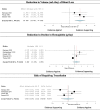Interventions to prevent iatrogenic anemia: a Laboratory Medicine Best Practices systematic review
- PMID: 31399052
- PMCID: PMC6688222
- DOI: 10.1186/s13054-019-2511-9
Interventions to prevent iatrogenic anemia: a Laboratory Medicine Best Practices systematic review
Abstract
Background: As many as 90% of patients develop anemia by their third day in an intensive care unit (ICU). We evaluated the efficacy of interventions to reduce phlebotomy-related blood loss on the volume of blood lost, hemoglobin levels, transfusions, and incidence of anemia.
Methods: We conducted a systematic review and meta-analysis using the Laboratory Medicine Best Practices (LMBP) systematic review methods for rating study quality and assessing the body of evidence. Searches of PubMed, Embase, Cochrane, Web of Science, PsychINFO, and CINAHL identified 2564 published references. We included studies of the impact of interventions to reduce phlebotomy-related blood loss on blood loss, hemoglobin levels, transfusions, or anemia among hospital inpatients. We excluded studies not published in English and studies that did not have a comparison group, did not report an outcome of interest, or were rated as poor quality. Twenty-one studies met these criteria. We conducted a meta-analysis if > 2 homogenous studies reported sufficient information for analysis.
Results: We found moderate, consistent evidence that devices that return blood from flushing venous or arterial lines to the patient reduced blood loss by approximately 25% in both neonatal ICU (NICU) and adult ICU patients [pooled estimate in adults, 24.7 (95% CI = 12.1-37.3)]. Bundled interventions that included blood conservation devices appeared to reduce blood loss by at least 25% (suggestive evidence). The evidence was insufficient to determine if these devices reduced hemoglobin decline or risk of anemia. The evidence suggested that small volume tubes reduced the risk of anemia, but was insufficient to determine if they affected the volume of blood loss or the rate of hemoglobin decline.
Conclusions: Moderate, consistent evidence indicated that devices that return blood from testing or flushing lines to the patient reduce the volume of blood loss by approximately 25% among ICU patients. The results of this systematic review support the use of blood conservation systems with arterial or venous catheters to eliminate blood waste when drawing blood for testing. The evidence was insufficient to conclude the devices impacted hemoglobin levels or transfusion rates. The use of small volume tubes may reduce the risk of anemia.
Keywords: Anemia; Blood conservation strategy; Clinical laboratory techniques; Iatrogenic diseases; Phlebotomy.
Conflict of interest statement
No authors, other than from RTI International, received funding for the study. The authors declare that they have no competing interests.
Figures
Similar articles
-
A Contemporary Analysis of Phlebotomy and Iatrogenic Anemia Development Throughout Hospitalization in Critically Ill Adults.Anesth Analg. 2022 Sep 1;135(3):501-510. doi: 10.1213/ANE.0000000000006127. Epub 2022 Aug 17. Anesth Analg. 2022. PMID: 35977360 Free PMC article.
-
Phlebotomy overdraw in the neonatal intensive care nursery.Pediatrics. 2000 Aug;106(2):E19. doi: 10.1542/peds.106.2.e19. Pediatrics. 2000. PMID: 10920175
-
Patient harm associated with serial phlebotomy and blood waste in the intensive care unit: A retrospective cohort study.PLoS One. 2021 Jan 13;16(1):e0243782. doi: 10.1371/journal.pone.0243782. eCollection 2021. PLoS One. 2021. PMID: 33439871 Free PMC article.
-
Blood conservation in the intensive care unit.Crit Care Med. 2003 Dec;31(12 Suppl):S715-20. doi: 10.1097/01.CCM.0000099350.50651.46. Crit Care Med. 2003. PMID: 14724470 Review.
-
Devices to Reduce the Volume of Blood Taken for Laboratory Testing in ICU Patients: A Systematic Review.J Intensive Care Med. 2020 Oct;35(10):1074-1079. doi: 10.1177/0885066618810374. Epub 2018 Nov 27. J Intensive Care Med. 2020. PMID: 30482081
Cited by
-
Treatment of Philadelphia chromosome-positive acute lymphoblastic leukemia in Jehovah's witness patients.Leuk Res Rep. 2024 Jul 24;22:100474. doi: 10.1016/j.lrr.2024.100474. eCollection 2024. Leuk Res Rep. 2024. PMID: 39175510 Free PMC article. No abstract available.
-
Best practices for iatrogenic anaemia prevention in the intensive care unit: Blood-sparing techniques.Nurs Crit Care. 2025 Jan;30(1):47-52. doi: 10.1111/nicc.13084. Epub 2024 Apr 23. Nurs Crit Care. 2025. PMID: 38654607 Free PMC article. Review.
-
Clot formation risk in the clearing fluid after arterial catheter blood sampling: coagulation factors consumption over time - a prospective pilot study.J Clin Monit Comput. 2025 Jun;39(3):607-612. doi: 10.1007/s10877-024-01252-0. Epub 2024 Dec 12. J Clin Monit Comput. 2025. PMID: 39665871
-
Partial pressure of oxygen, hyperoxemia and hyperoxia in the intensive care or anesthesia setting.Med Gas Res. 2026 Mar 1;16(1):53-58. doi: 10.4103/mgr.MEDGASRES-D-25-00028. Epub 2025 Jun 28. Med Gas Res. 2026. PMID: 40580189 Free PMC article. Review.
-
Essential Role of Patient Blood Management in a Pandemic: A Call for Action.Anesth Analg. 2020 Jul;131(1):74-85. doi: 10.1213/ANE.0000000000004844. Anesth Analg. 2020. PMID: 32243296 Free PMC article. Review.
References
-
- Silver MJ, Li YH, Gragg LA, Jubran F, Stoller JK. Reduction of blood loss from diagnostic sampling in critically ill patients using a blood-conserving arterial line system. Chest. 1993;104:1711–1715. - PubMed
-
- Nguyen BV, Bota DP, Melot C, Vincent JL. Time course of hemoglobin concentrations in nonbleeding intensive care unit patients. Crit Care Med. 2003;31:406–410. - PubMed
-
- Corwin HL, Gettinger A, Pearl RG, Fink MP, Levy MM, Abraham E, MacIntyre NR, Shabot MM, Duh MS, Shapiro MJ. The CRIT study: anemia and blood transfusion in the critically ill--current clinical practice in the United States. Crit Care Med. 2004;32(1):39–52. - PubMed
-
- Sanchez-Giron F, Alvarez-Mora F. Reduction of blood loss from laboratory testing in hospitalized adult patients using small-volume (pediatric) tubes. Arch Pathol Lab Med. 2008;132:1916–1919. - PubMed
Publication types
MeSH terms
Grants and funding
LinkOut - more resources
Full Text Sources
Medical
Research Materials
Miscellaneous




